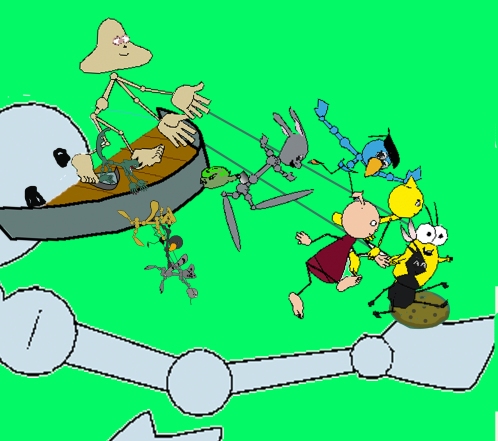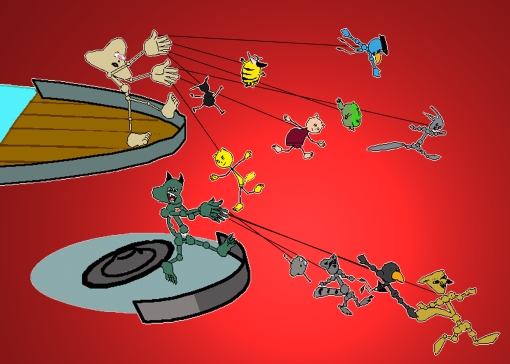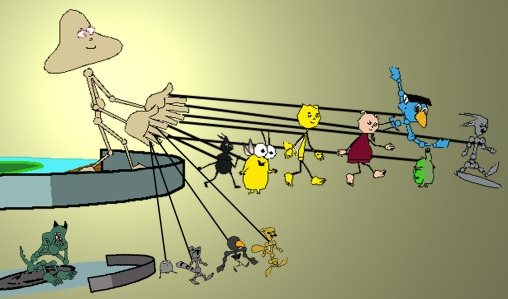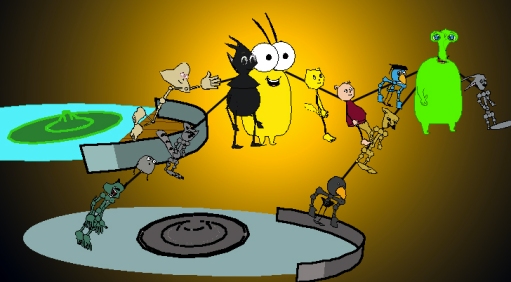So how do we gain maturity as fast and efficiently as possible and pass it on to our children? Lets look at each of the four steps our brains go through to answer that. The steps again are Perception, emotional response, planning, and acting. We have to hone in on better perception, workable emotionally response, better maps or beliefs to make a plan of action, and better skills and habits. The four steps need to communicate with and compliment each other, work together, coordinate together, like all the husky dogs that pull a dog sled, and keep the Lower Nature animals small and ineffective unless we need them in a dangerous situation.
Consciousness does that for us. That is if consciousness knows how. Consciousness is blind, emotionless, ignorant, and helpless without the four step widgets. And the four step widgets are blind to each other without communicating. Ant and Bee tell Macho (fear) and Cuddles (love) what is out there in the world, and Macho and Cuddles then tell Ant and Bee to look for danger or love objects. Then Geru chimes in with advice to do so or not to do so and adds what he/she thinks should be done. At this point Turtle yells patience as Rabbit expounds what he can or can not do, what his skills are. Geru then prompts Rabbit to do more, try more. Macho may yell Danger and the Lower Nature wants to take over to deceive, be greedy, blame, and or fight. The back and forth dialogue has no end or possible patterns. It can run like clockwork or it can be a complicated mess if Consciousness, Mr/Ms Do, can not focus and coordinate all the parts to solve the problems or reach goals. With the Upper Nature in Chaos Dragon can then take advantage of the situation and take the lead.
To be healthy we must balance all the widgets, keep them working together to accomplish our mission. Like a well ran dog sled, even the Lower Nature widgets.
To add to the complication of unbalance, each situation we find ourselves in can expound on or limits those possibilities and create more dead ends. And the most complicated situations of all are other people. There is nothing more complex in the Universe then another person’s mind. How can we understand others when we hardly understand ourselves. How can the brain see beyond itself to see itself and how it interacts with the the bigger then them Universe? Mr/Ms Do (consciousness) tackles that problem too. As he/she gets wiser so do we.
‘Situations?’ you say. ‘That’s a new step isn’t it?’
Well, you may be saying that yes, it is a fifth step. But wait, there are three more steps.
‘What? Three more?’
Yes, and together with situations that makes four more steps.
‘OK, what are the next three steps?’
The new steps are really just the original four steps but reinterpreted in a situation. So we have the biological traits of the child or we could say their predisposition to perceive, the family emotional dynamics the child was raised in, the belief systems they have, and the past, present, and foreseen future situations. In other words biology and genetics is what makes up a lot of a person’s perceptual ability, emotional limits, thinking levels, and potential actions, family shapes our emotional responses, belief systems help us plan what to do, and situations dictate which skills or habits we can use. So, really it is still four steps: perception, emotional response, thinking or planning, and actions.
‘What about Dragon and his crew? Is that not four extra steps?’
Dragon is only our alter consciousness or alter ego or our negative side. Tinted perception, selfishness, weird thoughts of blaming others, and aggressive responses are just the negative survival mode of the four steps. To perceive the lie, feel self centeredness, justify by blaming others, and acting without considering the other person’s Upper Nature is the job of the Lower Nature in situations where survival is at stake. It is fast and awkward but it still only the four steps; perception, emotions, thought or planning, and action.
So we perceive according to our genetic makeup, our raising, our beliefs, and our skills and habits in past, present, and perceived future situations. We perceive according to our genetics, our raising, our beliefs, and our skills and habits from past, present, and future. Our mood is dependent on our perceptions, emotional experiences, beliefs, and actions. We think according to our genetic potential, family dynamics, belief systems, and situational possibilities from past, present, and future. And we act according to genetic makeup, family habits, beliefs, and situational possibilities, past, present, and future.
All these variables change the size and strength of influence each widget has. Those variation make us who we are, when and where. We have a genetic predisposition that can be altered by accidents or drugs, by family, by beliefs, and by experience and situations. When widgets vary so does our limits and possibilities. Here is an example of the widgets of a typical Nurd, one who is detailed, a bit detached, concrete thinker, and inactive. Perception and patience rule and direct a lot of the show and all others are drug along. To help such a person fit into the mainstream we would need to calm down the focus on details, beef up their empathy, expand their concepts, and build a fire under their rabbit. If the Lower Nature is too active that too will have to be calmed.
Its evident that babies have genetic makeups, but until they grow, experience family, learn beliefs, and habits they are quit helpless and at a loss as to what to do. By nature their Lower Natures must be strong to survive. In young children the Consciousness is not as developed yet as their Dragon as Dragon is more hard wiring and conscious awareness is more learned so takes time and discernment. And this is where parents come in. Parents shape their children’s consciousness as they help develop their four step widgets, especially the Upper Nature.
To see the process we need to look at genetics, at family dynamics, at the structure of belief systems, and at skills and habits needed for situations of ourselves and our children. We then decide what we need to do to be able to help our children be able to control themselves so we do not have to police them constantly.
When you connect them all, Upper Nature and Lower Nature in real life situations, and you will be really cooking at the game of productive human interaction and communication and behavioral prediction.
So lets begin to look at how to change the limits of our children, what is needed to change them according to our own genetic, family, beliefs, and habits.
I will start with Infants, then toddlers, next young and older children, followed by adolescents.
That is the number one place parents come in. Consciousness coordinates with others and their widgets of perception, emotions, thoughts, and habits.
So lets start with step one perception, to see, hear, feel, taste, and smell the situation, to know what really happened.
That is not so simple, and may never really be completely known. But we can look at patterns, trends, and habits of others to begin to understand what they are doing by what they tended to do in the past. This can also be used to predict what they may do in the future. But the battle of the wills is shaped also by situations, that keep changing. So we have to look at the patterns and trends of the situations people are found in. Kids tend to act differently with mom then dad, with school then home, with their friends then strangers, a church then at a party. So the patterns of people’s behaviors changes within different situations. The brat at home may be an angel at school, or vice versa.



